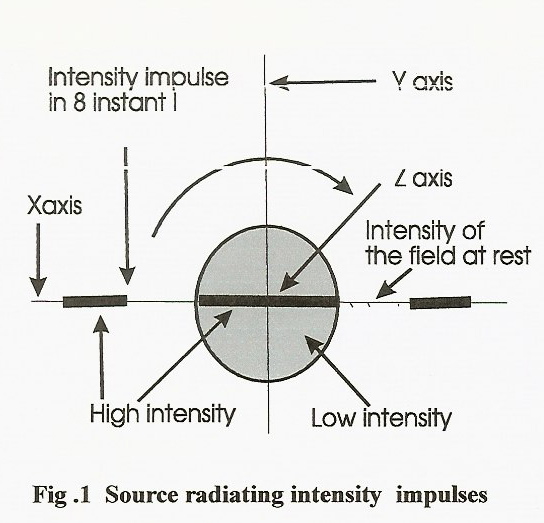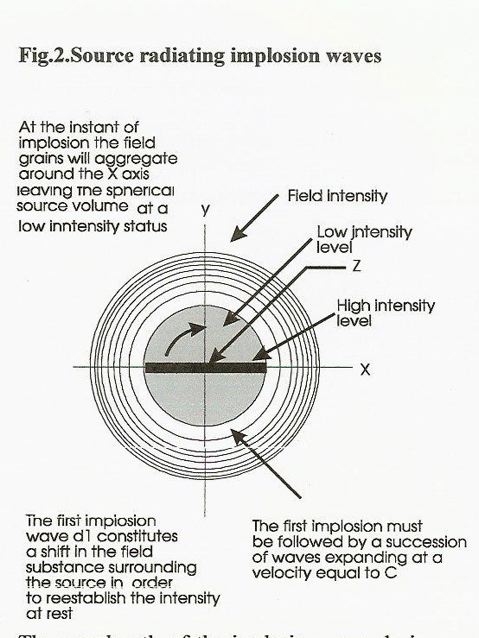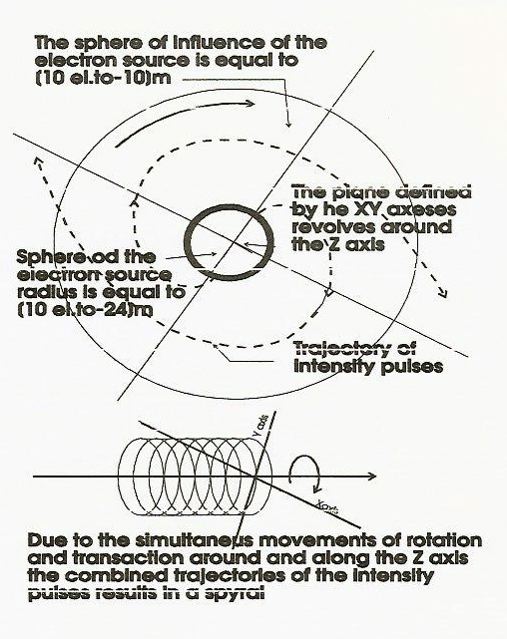The electron and positron sources If we discard the original hypothesis of a universal substance constituted by particles
acting on each other through other particles in a complete void, we will have to accept as the only essence of the universe
the substance of the field, in which energy localizes and act generating movements in its infinitesimal particles. I
cannot describe now the Universe as an infinity of nothing populated by an undefinable number of particles, each possessing
in themselves characteristics of mass and charge.
In trying to conceive a possible atomic model that we can envision under the principles of this new hypothesis, I
will have to describe a Universe that cannot be uniformly static, but must be viewed as an entity able to vary in intensity
with time, obeying laws that can be envisioned in a Cartesian space-time frame. I am following the ideas once entertained
by Faraday and Maxwell of a Universal field in which ( the field identifying the whole Universe). Impulses and distortions
developing in its medium are carried through it from point to point.
In describing an atomic model based on my new interpretation of the universal substance, I must
first postulate the laws necessarily related to the new principles that make possible its existence.
I stated in the previous chapter that a law must
necessarily exist requiring the field to maintain the same level of intensity throughout at a preestablished and constant
value that I have called intensity at rest. The second law derived from the first establishes that, when the energy localized
within a source increase or decrease its field intensity the created disturbances must disperse in the form of radiating energetic
Pulses and as implosion waves (this in order to restore the preestablished intensity level). In contrast with the previous
hypothesis of a material Ether where the disturbances generated in it were assumed to be waves of a three dimensional spherical
type, (like sound waves in the air) the field intensity radiation must be transmitted in a linear trajectory in the direction
of the force that generated them and must consist of a reduction or increase of the domains of each infinitesimal particle.
A third law must state that the volume V of a source domain and the energy of action Et generated in it must be in a constant
ratio V/Et [see clarification at end of chapter] . In the new concept . V/Et (Volume of source over Energy
of action of the same is constant equal to h x GeV-3 or h x 10 -45
m.^3 the Electron becomes a source of energy acting in
the field, not a substantial particle possessing physical characteristics in itself. With the word source we indicate a volume
of the field where energy is localizing in a definite spatial entity. The volume is assumed to be spherical, since the sphere
is the simplest natural form with complete and total symmetry and contains the greatest possible volume within the boundary
of its surface. This spherical volume of a source does not represent a substantial particle in itself but delimit a domain
in that portion of the field where under the action of energy, displacements in its elementary specs of substance will occur
in a recurring dynamic sequence. I also believe that the volmne of the source over its energy of action is constant..
The sources are actually representing the particles identified in physical science as Electron, Protons, Neutrons or any other
mass possessing particle. I consider the massless particles described in quantum mechanics to be impulses of positive
intensity radiating in the field creating spyral trajectories, therefore with an established charge (see drawing).
The size of the Electron could not be detennined experimentally.
In the quantum theory it is defined as an infinitesimal point called a singularity. This notion is impossible to comprehend,
how can we conceive a particle with a mass, a charge and a spin, but without a dimension in space?
In following classical physical considerations the diameter of the electron was
assumed by some scientists to have a value of less then 10-18
m.
For our suggested atomic model to be
viable (see chap. 16) I will have to assume that the sphere of the electron source must have a radius of 10-24m.,
and therefore a volume equal to Ve=4.118 x 10-72 m 3. The size of the electron radius was determined
by me( (see the end of this chapter) The energy localizing in the source will act dynamically on the surrounding field producing
variations of its intensity in a time-space continuum. (See figure 2) In our diagrammatic sketches we visualize the Electron
in a four dimensional space-time frame, defining it through three cardinal axes X, Y and Z. In sketch N 2 I describe
the electron source spherical volume to be imploding around the X axis, its XY plane rotating around the Z axis while moving
along it at a constant transitional velocity in a direction away from the observer. The imploding action varying in dimension
and timing from source to source will define the energetic input of the generated intensity impulses.
The rotation of the XY plane around theZ axis, being clockwise or counterclockwise
with respect to the transitional velocity vector endow the originated intensity impulses with their positive or negative electric
characteristics. A small part of the source energy is not imploding, but is contributing to the transitional velocity along
the Z axis which is at a minimum when the source is considered at rest, but increases proportionally with each additional
input of energy. The increased transitional velocity of the source is energy of heat that can be detected as a rising temperature.
As we observe in chap. 7 the volume of the non- imploding source of the Electron Vev is equal to I0 -6 Ve.(See chap. 10)
Since
the electron total energy of action at rest Eet is equal to 0.51 x 10 6 eV x sec the energy of action within
the volume Vev being proportional to it must be:
Eev = 0.51 eV x sec. The non -imploding energy of an electron and positron particle when at rest is: 1/1000000000
of its total energy of action . Analyzing within a dimension of time the disturbances generated by a source in
the substance of the Field, I must believe in the existence of a universal clock counting instants in infinitesimal units.
A unit of time that I find useful in the description of our atomic model is the instant i representing the time taken by an
electromagnetic wave traveling in empty space to cross a distance equal to 1/4 the dimension of the electron source radius
and also equal to an electronic intensity Pulse.
I have stated that for our atomic model to be valid the dimension of the Electron source radius must be 10 -24
m. If v = velocity, s = distance,i = instant of time
v = s/l I = s/v s indicate
space t indicates time
v indicats volume
s = 0.25
x re t= C = 3 x 10 8 m x sec
t = 0.25 x 10-24 m / 3 x 108 m / sec = 0.083
x 10 ^-16 m / sec.
t =
0.083 x 10-32 / sec = 8.3 x 10-34 m / sec
The Electron source imploding around a segment of the X axis produces in eight
instant i, two intensity impulses. Each impulse is constituted by four pulses in four instants i with a total negative intensity
equal to
0.5 x 0.51 x 106 eV = 0.255 x 106 eV = 2.55 x 105 eV
followed by four instant i where the intensity of the field is at rest,
completing in eight instant of time i two intensity impulses proceeding in opposite directions impulses speeding in opposite
direction in a rectilinear trajectory at the velocity of light C., each with a wavelength equal to l0-24 m and
a total intensity of approximately 2.55 x 10 -5 eV. (see sketch NA) During the source implosion the field
particles in the Electron will aggregate at a source diameter and then radiate in a linear direction away from the center
of the source into separate impulses. In the Particle Physic Atomic model we can imagine that some of these particles are
motionless relatively to us, but in the new hypothesis in which energy is localizing in spherical sources creating wavelike
motions in its elementary parts, we cannot describe them being at rest (how can a wavelike motion be still?). I assign to
these sources, when considered at rest, a minimum possible value, both in their total energy and in their transitional velocity.
When the spherical volume of a source implodes around the X axis generating this way intensity impulses, another type of disturbance
is created in the field.
During
the implosion the Field substance within the source spherical volume will be at that instant at a lower intensity level than
the surrounding field. In order to correct the imbalance, Pulses of intensity in the surrounding Field must shift toward the
source's inside, (an action that will generate a different type of wavelike disturbance). I will call the disturbance
implosion wave.
The
implosion waves are than representing a shift of intensity in the field substance surrounding the source spherical volume
occuring in order to fill-in the created vacuum. This shifting of particles toward the source must expand as a wave away from
the disturbance center at a velocity that must be equal to the speed of light C. The mechanical dynamics of the implosion
waves will be described in another chapter, but their action on the field must be considered when analyzing the properties
of our suggested electronic source model. As described in sketch N.3 the shifting of the implosion forces will act on the
intensity pulses created by the Electron, as a result curving their trajectories into a spiral winding around the source.
In the Electron source the intensity pulses will escape the action of the implosion forces at a distance of 10-10
m, representing the estimated radius of an atom and of a sphere that I will call the zone of interference of the electron
source.
The
positron source aspects and dynamics are similar to the electron source's, with the exception of the direction-of gyration
around the Z axis, that must be opposite in sign in order to originate an opposite charge. (See chapt.8) Further on I will
describe the Neutron and Proton sources that are constituting the Atom Nucleus and subsequently we will advance a possible
model of the atom derived from Rutherford original, which we conceive as he did in a space time cardinal trame. By our description
of the electron and proton energy sources the essence of the new model of the atom will not be constituted by substantial
particles, but only by intensity changes originated by energy. localizing in spherical volume of the field
One advantage we already have
over the particle hypothesis is that with this new theory we don't have to deal with the problem
of action at a distance in an empty space since we can envision sources of energy that influence each other by exchanging intensity impulses and implosion waves through the substance of the field itself and
not by ejecting mysterious virtual particles. I want to clarify my statements in my beliefs in a Universal low stating that
for every sourse the equation V/Et is a constant.



[I cannot say I can prove it as a
fact, but in my calculations, the possibility of its truth is good. I first took the only particle we are pretty sure we know
the spherical radius r as being an atomic nucleus or a Proton. A Proton radius was estimated to be close to 10-15m.
Or 1 GeV-1.
(Since Rutherford)
VP = 4.188 x 1 GeV-3
Et = 1 GeV x1sec. =1GeV x 10 -24GeV ^-1x sec =h x sec.
VP/ Et = K In
the natural system of units the value of 10-24 is given to the Planck constant h.
VP/ Et is equal
to h x sec. x GeV^-3